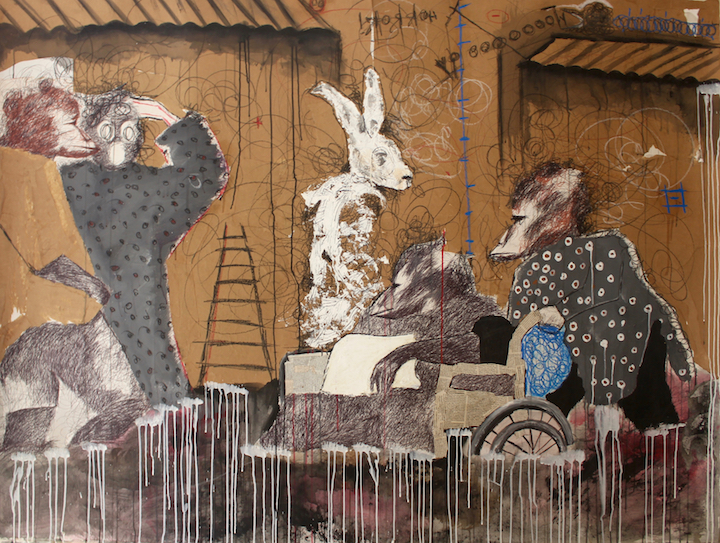Newsday: Stony Brook Gallery Showcases Senegalese Artists
BY: Deidre S. Greben
Special to Newsday
POSTED: September 7, 2019 8:00 AM

“Horror District” by Ibrahima Dieye is one of the works featured in “The View From
Here” exhibit of
Senegalese artists at Paul W. Zuccaire Gallery in Stony Brook.. Photo Credit: Ibrahima
Dieye
Museum-goers expect to find labels identifying the artist, title and media of the
works on view. What visitors to Stony Brook University’s Paul W. Zuccaire Gallery
may not expect to see are descriptions they don’t understand.
That is because they are written in Wolof, a Niger-Congo language spoken in some West African countries, including the one spotlighted in “The View From Here: Contemporary Perspectives From Senegal,” a group exhibition showcasing 11 artists connected to the African nation. According to organizing curator Joseph Underwood, the way in which the information is listed — also in French (Senegal’s colonial-era tongue) and then English — emphasizes the show’s premise.
“It suggests we are not the works’ main audience. It is in their language,” he says. “It is not meant as an insult, but to make us ask, ‘What if the world was not designed for you?’ ”
Also shattering expectations is the exhibition’s content. Comprising photographs, paintings, works on paper, installation and video, the imagery is divided into three themes (Urban Textures; Icons and Symbols, and Negotiated Identities) that “could just as easily feature in a show of work in L.A.,” Underwood notes.
Dakar artist Ibrahima Dieye, for example, addresses challenges in densely populated areas using allegoric animal-hybrid figures, thereby evading local political censorship while simultaneously endowing his compositions with universal relevance. Amalia Ramanankirahina, a Parisian artist of Madagascan lineage whose connection to Senegal is as a transient visitor, calls attention to the country’s colonial history with stark, emblematic ink drawings on delicate cellulose paper from her “Trial Gardens” series. “She uses the idea of borrowing from other cultures, but undermines it,” says Underwood.
Brooklyn photographer Laylah Amatullah Barrayn trains her lens on Senegalese life as an outsider, though, after studying in the region years ago, she considers the country her spiritual home. By focusing on less geographically accessible areas, Barrayn expands the notion of what Senegal is.
Underwood’s interest in Senegal and its contemporary art scene also evolved from studying there, directed by his academic pursuits in art history and French. “When I went to write a report about Senegalese artists, there were hardly any resources available, maybe two books,” he says. “I wanted to make a contribution and change that.”
And he has. After debuting at the contemporary African art fair Dakar Biennale in Senegal as part of its OFF program, the exhibition traveled to multiple locations in the United States, with the Staller Center’s Zuccaire Gallery its final venue.
“I’m not saying these artists are the most talented or highly sought,” says Underwood of the sampling of works on view, “but they offer different perspectives told from different perspectives and received by different perspectives.” To be sure, the curator, regardless the language, has made art from Senegal part of the contemporary conversation.
Museum-goers expect to find labels identifying the artist, title and media of the
works on view. What visitors to Stony Brook University’s Paul W. Zuccaire Gallery
may not expect to see are descriptions they don’t understand.
https://www.newsday.com/entertainment/long-island/museums/the-view-from-here-senegal-1.35973834
